Temperatures in the United States can drop to well below -58°F (-50°C) and we deal with this by putting on many layers of thermal clothing. Birds however are stuck out there in the cold with only their feathers to keep them warm. How do birds not freeze during cold winters?
Birds do not freeze during cold winters as they have various physical traits that keep them warm. Two examples are insulating feathers called down and countercurrent circulation that helps avoid heat loss through their legs and feet. Birds also alter their behavior when it is cold to conserve heat.
There are many other ways in which birds stay warm when it’s cold. In the remainder of this article, we are going to explore more of the incredible physical and behavioral adaptations that keep birds warm, even in some of the coldest climates on Earth.

As an Amazon Associate, I earn from qualifying purchases. Birdwatch World earns commissions from Amazon and similar affiliate programs from any purchases made via links in this article.
Bird Body Temperature Basics
Birds, like humans and many other animals, thermoregulate or keep their body temperature within a specific range that is usually different from the ambient temperature. Daytime core body temperature for birds is usually 39-43°C (102-109°F).
Birds and mammals are the only groups of animals that regulate their body temperature mostly with heat generated by internal bodily functions. This is called endothermy.
Birds have slightly higher core temperatures than mammals, possibly because this higher temperature keeps their muscles ready for spontaneous flight.

Maintaining such a high body temperature requires the use of a large amount of a bird’s total energy consumption. The average metabolic rate of a bird is in fact 10 times that of a similar-sized reptile. This means that birds living in colder climates are still able to move about to forage for food or defend their territories.
Find out where birds go at night during the winter in this article here.
Feathers – The First Line Of Defense Against The Cold
The first defense a bird has against freezing are its feathers. Not only are they perfectly designed for flight but they are also remarkably effective at keeping a bird insulated against the cold.
Down Feathers
In the second paragraph of this post, I wrote about down feathers. These are the fluffy, soft feathers closest to a bird’s body. There are three types of down feathers:
Natal Down – usually covers a bird’s entire body around the time of hatching.

Natal down protects newly hatched birds from cold environments. Hatchlings will have varying amounts of down feathers covering their bodies depending on what category of species they fit into.
Birds such as the Cape Barron Goose gosling above are what is called Precocial. These are birds that are born able to fend for themselves; they can walk, run, and even fly soon after hatching and will find their own food. A fluffy layer of down covering their entire bodies is necessary to keep them protected and warm.
Altricial species are born blind and helpless and will have little or no down whatsoever. These birds get their warmth from their parents during their first stages of life. As down feathers are so incredibly efficient at trapping heat within a chick’s body, they will also prevent heat transfer between the chick and the parent which would be undesirable.
Read more about precocial and altricial bird species in this article here on my blog.
Body down – lies under the contour feathers (the exterior feathers).
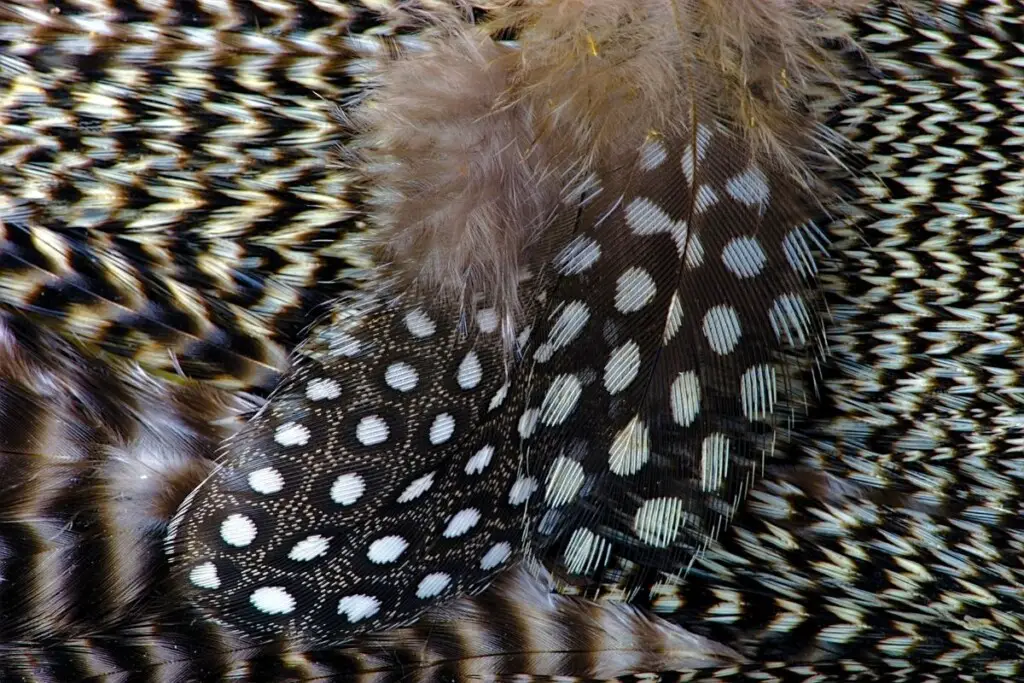
Body down feathers grow from the same shaft as the contour feathers, though the follicles that produce them only grow down feathers.
Down feathers have such incredible insulating properties that they have been used by humans for centuries in clothing and bedding. There is no better way to stay warm.
Songbirds that live in cold climates will grow more feathers in the winter to add extra insulation. They can have as many as 600 more down feathers than at any other time of the year.
Powder down – special down feathers that grow continuously and disintegrate at their ends to produce a fine powder. Parrots, Tinamous, and Herons have this type of down.

Powder down feathers are unique in that they are never molted. These specialized feathers produce a powdery substance made from keratin. This substance has the texture of talcum powder and helps to waterproof the feathers.
These types of down feathers can be scattered throughout a bird’s plumage or grouped in patches.
Contour Feathers
These are the feathers that cover most of the body of an adult bird. They are called contour feathers because they give a bird its shape. These feathers have many purposes and one of them is helping with thermoregulation.
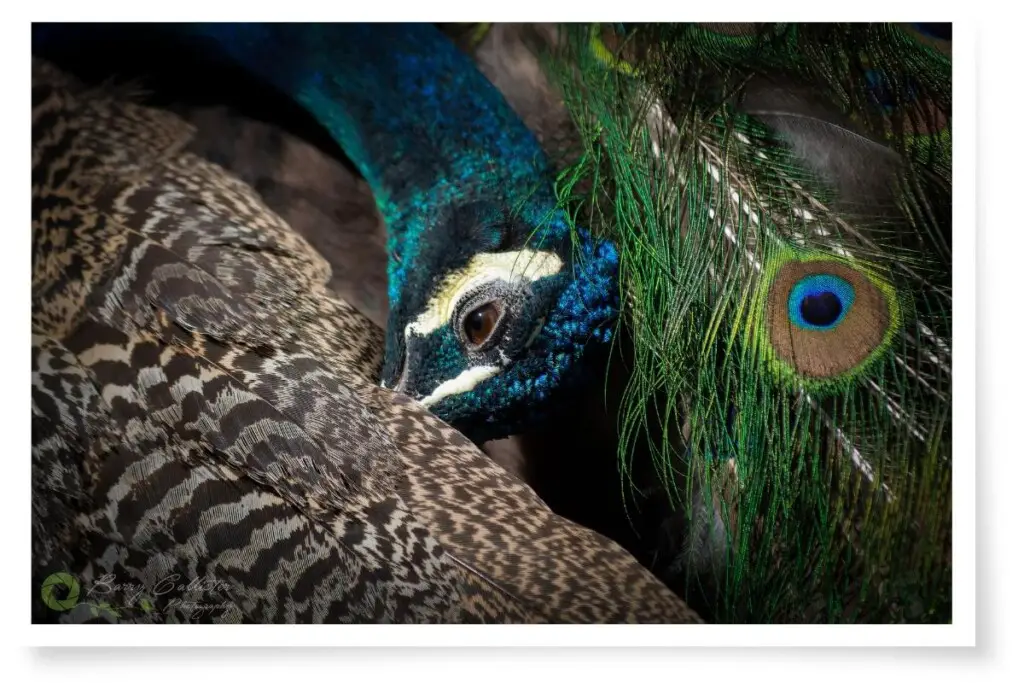
Contour feathers keep birds warm in various ways:
- How they are layered over each other like shingles on a roof provides an effective barrier. Their waterproof properties help to keep water away from a bird’s body and its down feathers which aids in staying warm.
- The contour feathers also provide a functional wind barrier; keeping cool air out and also helping to keep warm air trapped closer to the bird’s body.
- These outer feathers also reflect or absorb sunlight which helps a bird to stay warm.
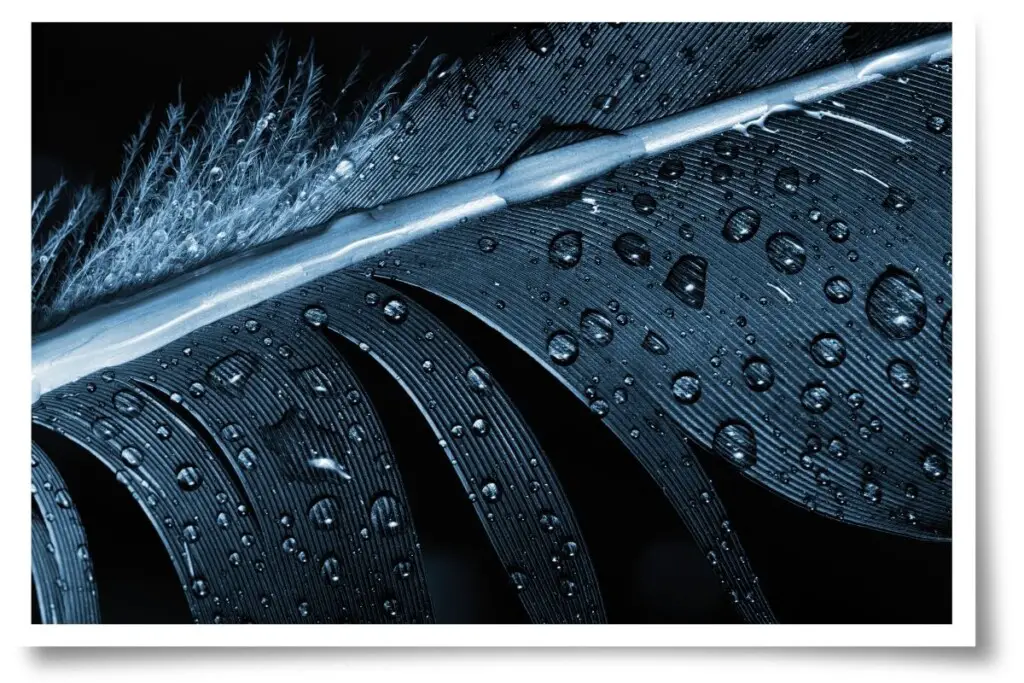
How do birds keep their feathers clean? Find out in this post on my site.
Fluffing Up The Feathers
Birds can increase the warming effects of their feathers by fluffing them up when it’s really cold. You might have seen a puffed-up bird on occasion.
Fluffing up their feathers like this traps warm pockets of air close to their skin, making it easier to maintain their body temperature.
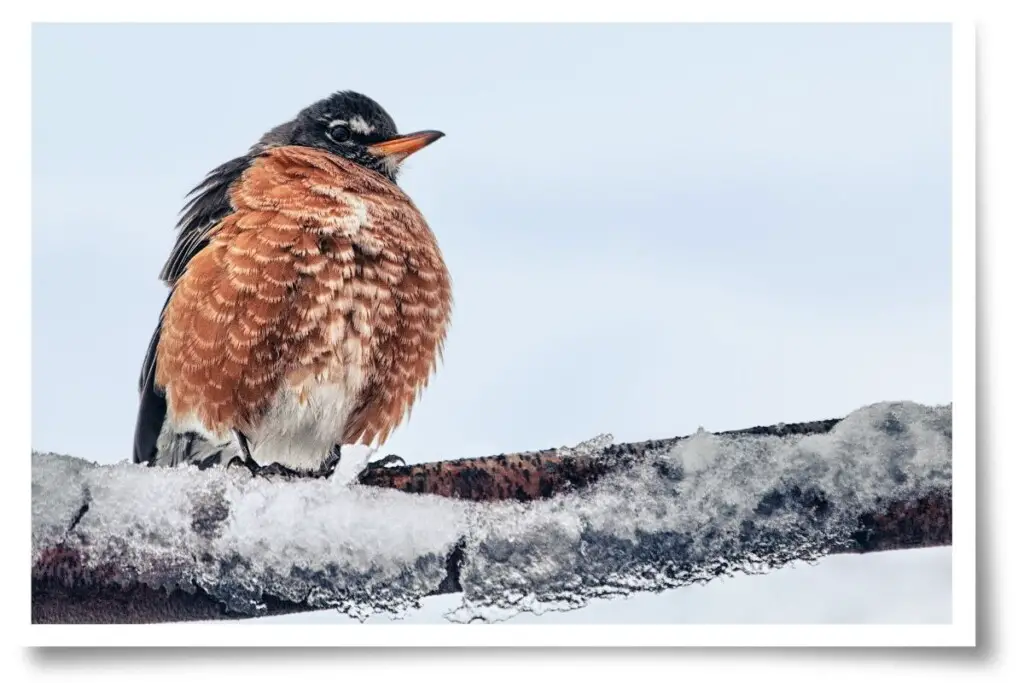
Discover the other reasons why birds puff up in this article here on my blog.
Finding A Warm Place
Even though their feathers are very efficient at stopping them from freezing, it doesn’t hurt a bird to find a nice warm place to roost on a cold winter’s night.
Finding a hollow in a tree or a crevice in a rock that is sheltered from the elements is a great way for a bird to stay warm. A lot of birds in cold climates will find some kind of protected area to sleep in at night, even if it’s just snuggling up to the trunk of a tree.
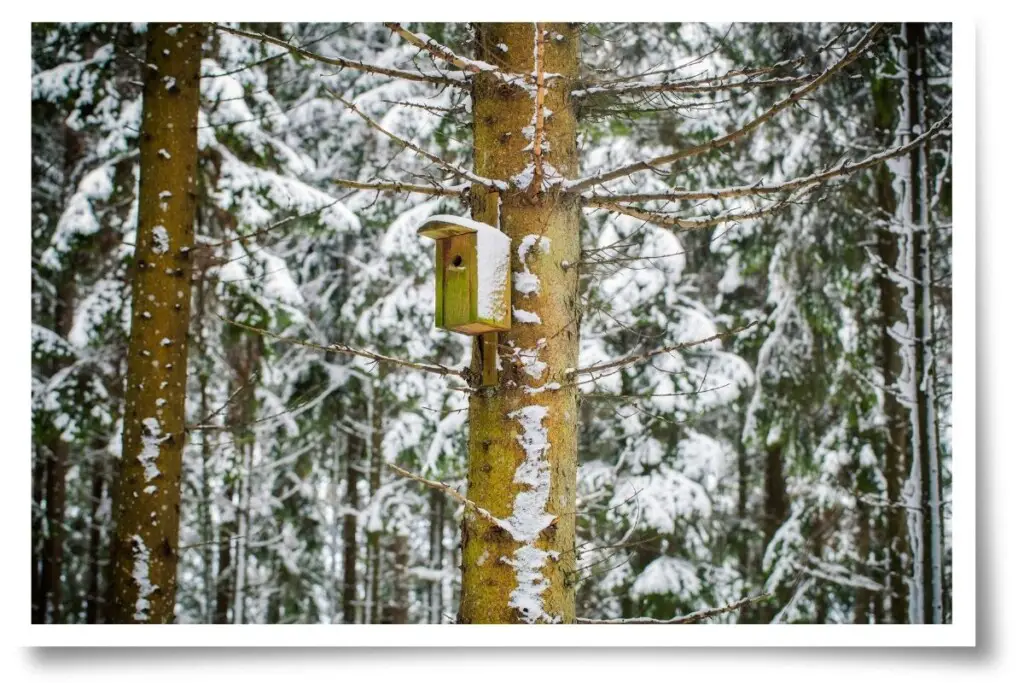
Putting up a birdhouse such as the one in the picture above can be a great idea in the winter. These provide extra refuges for the birds to use.
Another technique birds will use to keep warm at night is huddling together to conserve body heat. Birds such as Starlings, Swallows, and Swifts will often do this.
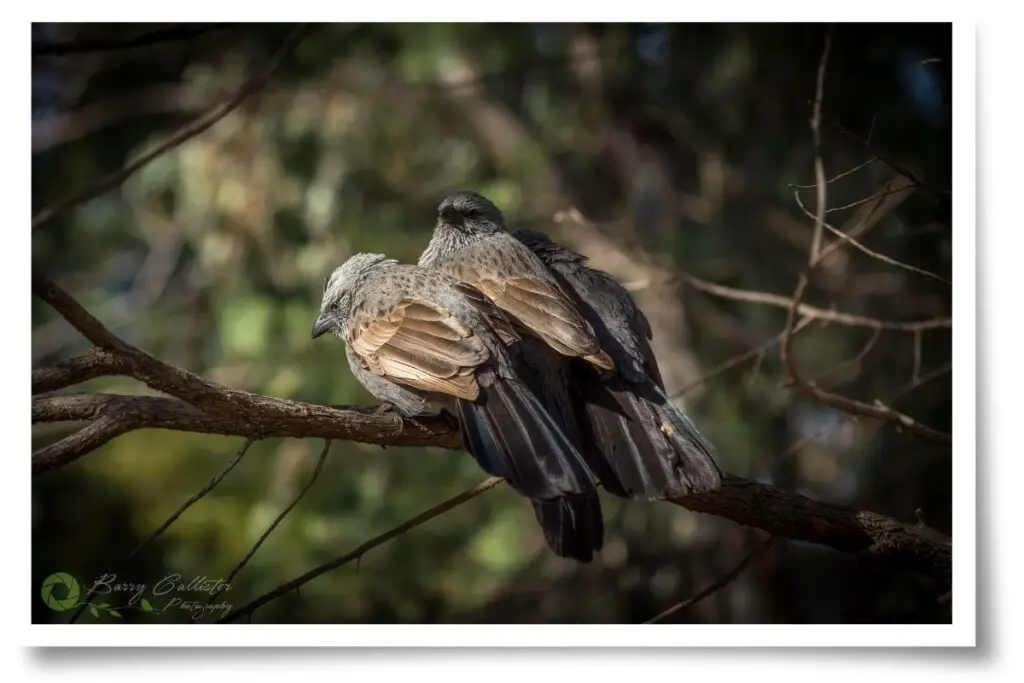
How Birds’ Legs And Feet Do Not Freeze
It is all well and good that birds have feathers on their bodies to protect them from the cold but what about their legs and feet? They are always exposed to the elements, so how does a bird prevent them from freezing? The answer to this question is countercurrent circulation.
The major veins and arteries in a bird’s leg split into multiple smaller blood vessels at the tops of the legs. These vessels intertwine to allow heat transfer from warm outgoing blood to cold incoming blood.
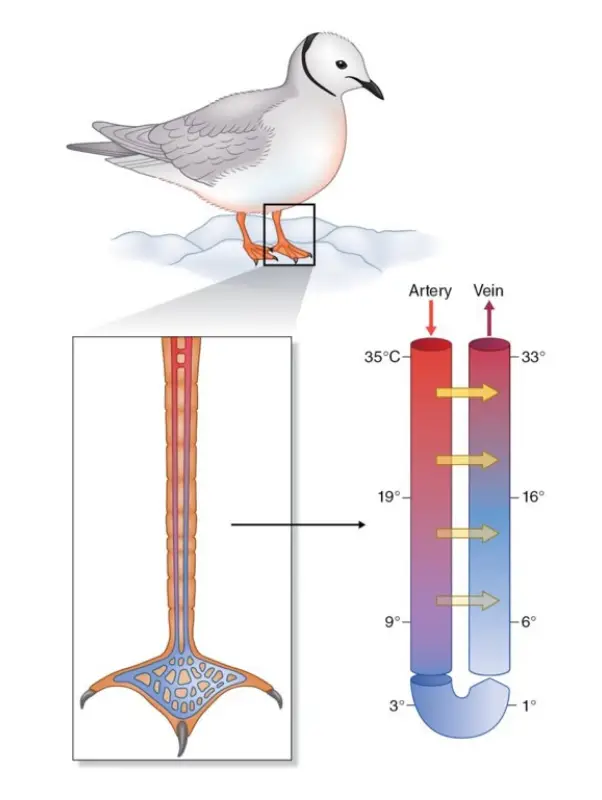
As much as 85% of the heat of the outgoing blood is transferred to the incoming blood. This is a very efficient system that ensures the bird’s core temperature does not drop below an optimal level.
Physical Traits That Reduce Cold Exposure
A bird’s legs and feet are not the only parts of its body that are exposed to the elements; its beak is also uncovered. These exposed areas of the body can result in a lot of heat loss. Nature has devised a solution to this.

Birds that live in colder climates tend to have smaller feet and bills compared to those that live in warmer, tropical climates. These physical traits have developed over many, many years.
The exception to this seems to be the Atlantic Puffin. These birds live in very cold areas such as Greenland, Iceland, and Norway and yet have quite large, broad, and colorful bills. The reason for this seems to be so they can carry multiple fish at the same time to feed their young.
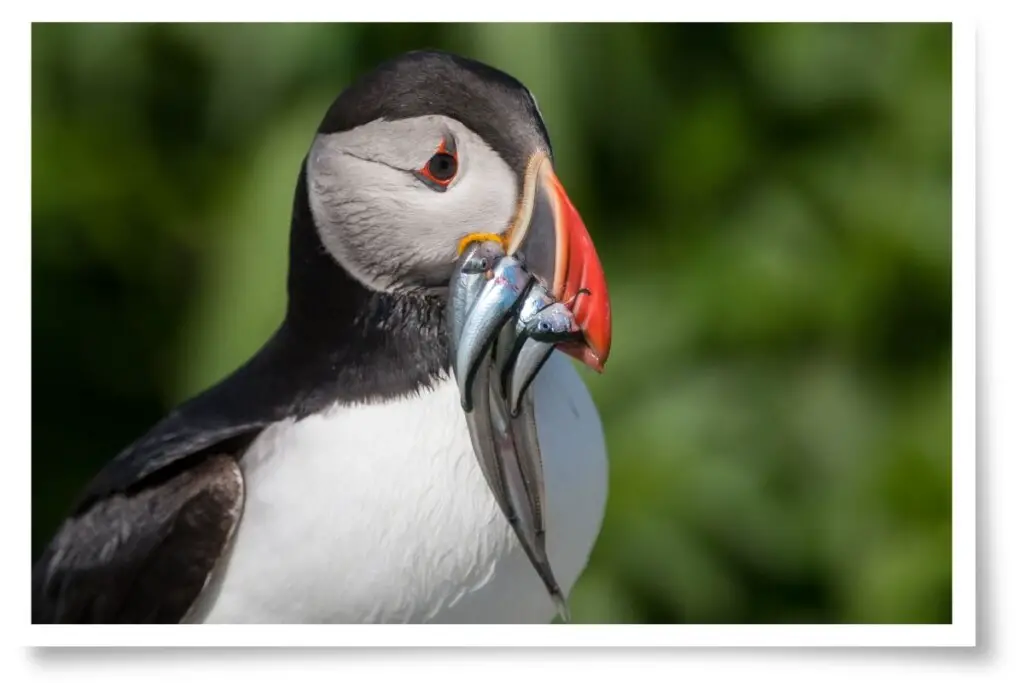
Bird Hibernation
The heading for this section is a little misleading – birds do not hibernate. Some birds do however enter a hibernation-like state called torpor. This involves not warming the body but cooling it down to avoid using huge amounts of energy to stay warm in bad weather.
Torpor is a resting state in which the bird’s body temperature drops, its metabolism slows, and its reactions to external stimuli are slow or absent. There are two types of torpor: shallow torpor and deep torpor.
Shallow torpor involves a modest decline in body temperature, usually no lower than 30°C (86°F). Birds such as vultures, anis, doves, quails, and some songbirds have been observed doing this. It is sometimes called nocturnal hypothermia.

Deep torpor involves a reduction in body temperature to a point where the bird can no longer respond to external stimuli. Hummingbirds, Poorwills, Nightjars, Mousebirds, and some Swifts engage in this type of torpor.
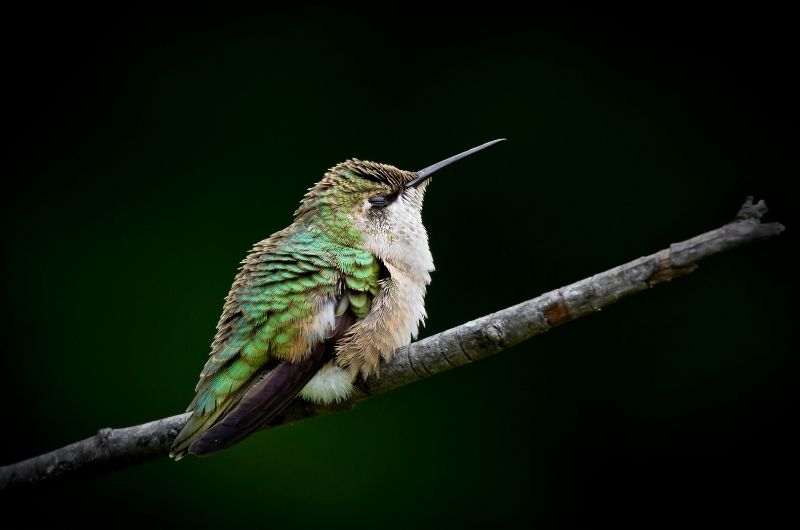
Birds that enter a state of torpor are quite vulnerable to predators as they can be completely unresponsive when in the torpor state. As a result of this, most species will only resort to torpor when they are facing very inclement weather.
There are however some species of hummingbirds in the high Andes that use torpor essentially every night! You would hope they find well-protected hiding places in which to do this.
Conclusion
Those are the various and amazing ways that birds do not freeze. Even though they are exposed to the elements daily, they are more than well-equipped to handle it.
Human beings are not so well-equipped and need layers of protective clothing to stay warm in such climates. Without our insulating clothing, we would perish within minutes in some of the temperatures birds endure daily.
References
- The Handbook Of Bird Biology – The Cornell Lab Of Ornithology
- Birds Of The World – The Cornell Lab Of Ornithology
- What It’s Like To Be A Bird – David Allen Sibley
- Down Feather – Wikipedia
